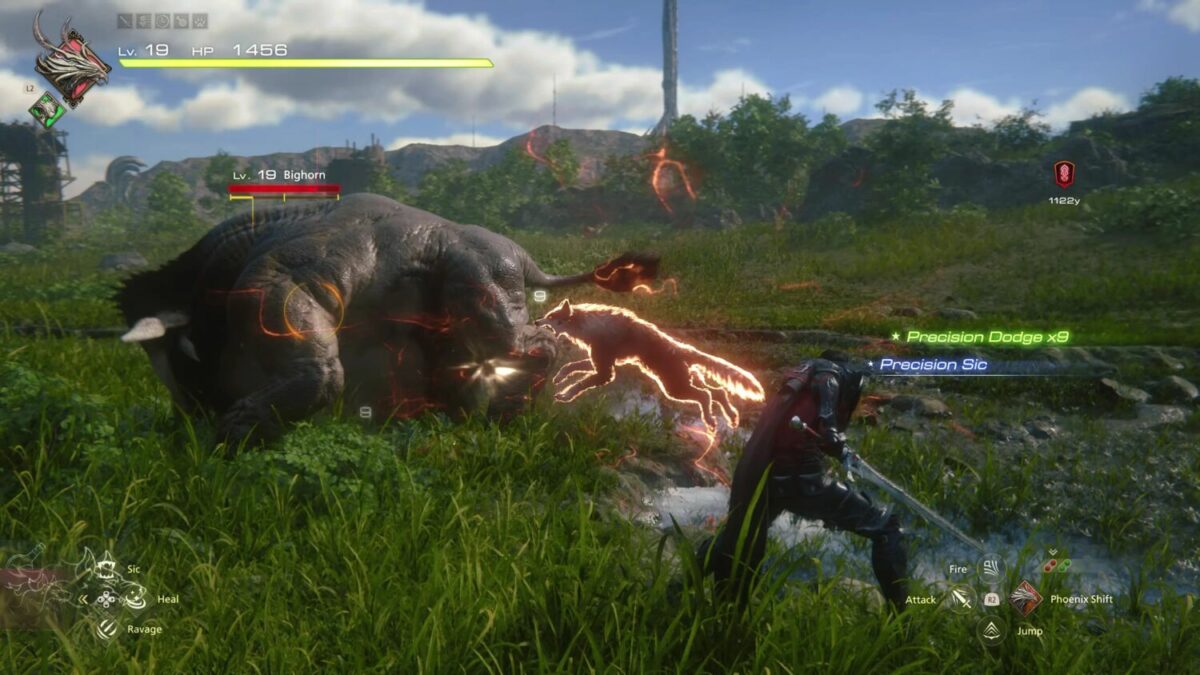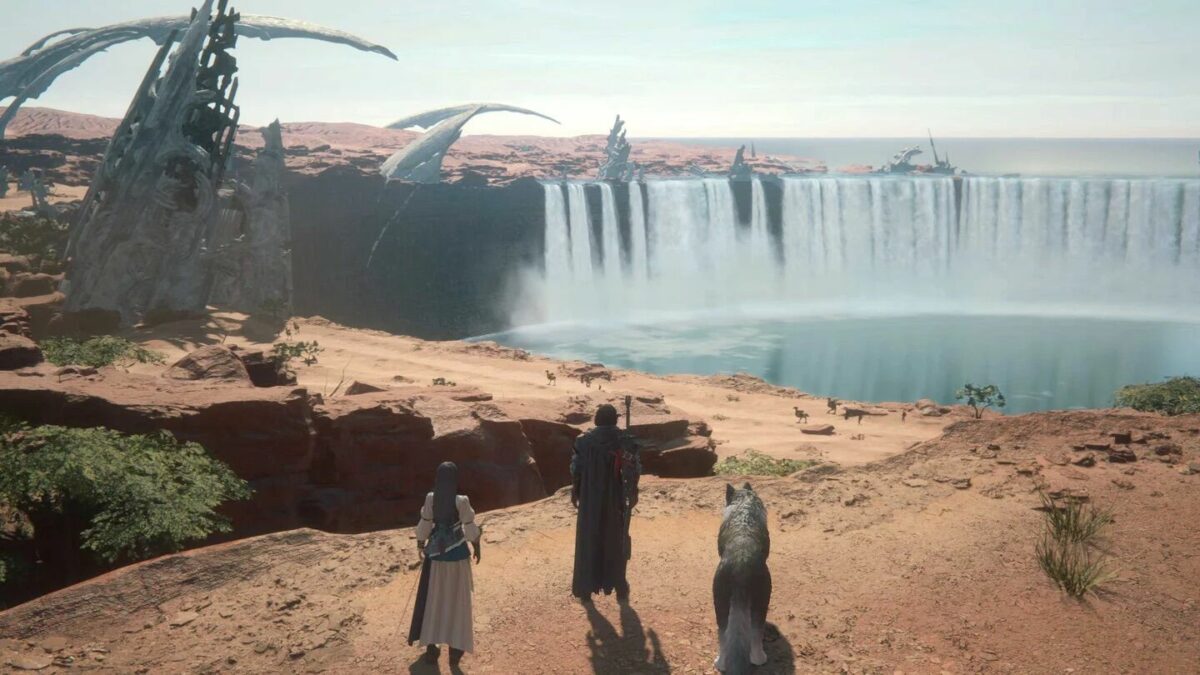Final Fantasy XVI starts out full of life and colour but in less than 60 seconds into the opening sequence, the screen is awash with rippling hues as Eikons Phoenix and Ifrit – names that should be familiar to franchise veterans – breathe and throw fire at each other. It’s energetic and dynamic, immediately thrusting players into the heat of the action, teasing them with breathtaking animation and gorgeously rendered cutscenes.

Beneath the vibrant, flashy presentation, though, lies a whole lot of darkness. The latest entry by Square Enix is a tale of grit, soaked in gratuitous bloodshed, political intrigue, and grim overtones. There are F-bombs and unfiltered insults, while the spray of red and brutal deaths are a staple on the battlefield. Enslavement, discrimination, and child exploitation are the normal state of affairs in Valisthea. Final Fantasy XVI doesn’t shy away from any of that, and it’s a good look for a series that has always explored heavy, mature themes, but presented them in a more palatable manner.
In embracing a no-holds-barred approach, the action role-playing game (APRG) carves out a distinct identity in a long-running legacy to proudly call its own, offering a breath of fresh air that promises a delightful, if sobering, journey in wait. It’s a study in tragedy and hope rolled into one, with a highly satisfying emotional payoff at the end of the road that makes the experience – defeats, triumphs, and everything in between – very much worthwhile.

Marking a return to its medieval fantasy roots, Final Fantasy XVI is set in the fictional realm of Valisthea, a world divided between six nations that gather aether energy from the Mothercrystals. A select handful who can cast spells without them is an exception to the rule: Bearers, recognised by the mark on their face and often subjected to enslavement, abuse, and widespread disdain; and Dominants, humans who act as hosts for each nation’s Eikon, a mythical being that takes after the Summons from past Final Fantasy entries.
These godly entities, each representing an element, typically don’t fight one another, but a land-consuming plague called the Blight causes escalating tensions between the nations. On a fateful night, protagonist Clive Rosfield, guardian to his younger brother and Phoenix Dominant Joshua, witnesses the destruction of his kingdom, as the latter prepares for his role as the Archduke of Rosaria. In the ensuing battle, a second Eikon of fire, Ifrit, manifests, bringing significant devastation and setting off a chain of tragedies that leads Clive to embark on a quest of vengeance, where he seeks out Ifrit and his Dominant.

What unfolds over the course of 40 or so hours is a poignant, emotionally wrought journey deeply entrenched in rich worldbuilding. There’s a lot to unpack, and Final Fantasy XVI dedicates most of its first half to establishing the overarching lore before picking up the pace in the second leg of the story.
As a result of this story-heavy presentation, the cutscenes do eat quite a fair bit into gameplay, and will sometimes jump to a concurrent occurrence elsewhere, making them more drawn out than some might be comfortable with. Admittedly, the dense exposition won’t be everyone’s cup of tea, especially in the first half, where gameplay leans into passive territory. It all proves necessary in the long run, however, as contextual knowledge will eventually play a vital role in the narrative fabric.

A notable, nifty feature here is the Active Time Lore, which gives an overview of the characters, events, and the world of Valisthea at large. The information is updated as the story progresses, with other information sources in the Hideaway, the base of operations, coming in handy for further understanding and knowledge.
At its best, Final Fantasy XVI shines with its own spin on well-worn tropes and themes. The storytelling elements have seen countless forms over the years, from early-century literary epics to modern takes. The notion of man versus god and determinism versus free will was explored in Homer’s The Odyssey, highlighted in Shakespeare’s King Lear (“As flies to wanton boys are we to the gods / They kill us for their sport), and carried over to Rick Riordan’s Percy Jackson series of novels; the political warring landscape is reminiscent of Game of Thrones or Lord of the Rings.
Even the general themes of morality and vengeance are as old as time, and it’s never easy to breathe new life into such retellings. Yet, Square Enix’s latest brings a masterful storytelling touch that accepts – then subverts – conventions, combines them on occasion, and, more importantly, injects a lethal emotional dose. It’s an undertaking of grief and healing, of saving others and saving yourself, of failing and succeeding, of sacrifice and acceptance, and a profound examination of what it means to be human, what it means to survive.

Admittedly, there will be lull moments that serve as a break from the frenetic on-screen action, which can feel like filler, particularly when there’s back-and-forth travelling involved. As such, the pacing may come across as uneven for some, even if it does little to break the entire narrative flow.
The characterisation lends itself well to the story, too. With eight Dominants at the centre of Final Fantasy XVI, it’s difficult to dedicate equal effort in fleshing out their characters, and there indeed are those who could do with a bit more development. Jill Warrick, the Dominant of Shiva and trusted confidant to Clive, is one such example – while she does get some time to shine as a main character, there’s still plenty of room to delve deeper into her inner conflict.

But others, like Clive and Cidolfus “Cid” Telamon, the Dominant of Ramuh and an allusion to previous incarnations of Cid in the series, are strong, memorable characters in their own right. A complex protagonist, Clive enjoys a nuanced portrayal that makes it easy to root for him as he navigates through his past mistakes, emotional vulnerability, moral conflicts, and personal tragedies. Cid, meanwhile, charms with his quick wit, easygoing personality, and admirable ambition to bring change to the world.
Where the game truly finds its footing, though, is in combat. Unlike its predecessors, Final Fantasy XVI embraces the shift to full-time action in the vein of Capcom’s Devil May Cry, and it’s a bold move that has paid off very handsomely. Part of the credit goes to combat director Ryota Suzuki, who drew on his previous experience with, surprise, Devil May Cry to deliver fluid, fast-paced gameplay. Combo chaining is a joy, and the combat system offers an added layer of complexity, with players juggling between assigning commands to Torgal, Clive’s faithful hound, switching between various Eikon styles, and activating the equipped powers.

At any one time, three Eikon styles and two corresponding abilities, along with a basic attack or skill, can be equipped and cycled through. It’s familiar ground for Devil May Cry fans, but the execution here is a little less intuitive – where its Capcom counterpart binds the fighting styles to the directional keys on the DualSense, Final Fantasy XVI uses the L2 button to switch them out. Because it only goes in one direction, hopping back to a previous style will require an extra press or two (basically going through the 1 → 2 → 3 motion instead of jumping from 1 → 3 with just the keys), which can be the difference between life and death in boss battles.
Still, the breakneck action is plenty of fun. Executing a perfect dodge, parry, or block grants a satisfying adrenaline rush, and there’s nothing more addictive than dishing out a devastating flurry of blows after the enemy is stunned, triggered by filling up the Stagger meter. There’s also a lot of room to explore and string together different combinations, as players will be able to customise or upgrade their Eikon abilities and take them out for a spin at the training arena.

If all of that sounds overwhelming, the game includes assistance in the form of Timely Accessories. These nifty items make it easier to track and handle all the frenetic action on the battlefield, from slowing down enemy attacks for a greater dodge window to automatically assigning commands to Torgal. Doing so takes up one equipment slot, but it comes in very handy in a pinch.

The Eikon-versus-Eikon showdown brings a different brand of novelty to the formula. In Final Fantasy XVI, Dominants like Clive can call upon their Eikons and transform into them during battles, setting the stage for a grandiose, magnificent spectacle. Building on the already breathtaking visuals in the cinematic sequences that trigger during boss fights – dubbed Cinematic Clash – and feature quick-time events (QTEs), these encounters take things to even more epic, stunning, and enthralling heights. From gorgeous, detailed rendering to bewitching animation, every cutscene is a cinematic masterpiece.
More impressively, the fighting style and movement have been tailored to fit each Eikon. As Ifrit, the player will feel slower and encumbered by lumbering steps, but can use a powerful lunge to close the gap between them and their opponent. Phoenix, meanwhile, glides gracefully through the air, and combines a fleet-footed experience with airborne shooting mechanics. Certain Summon techniques from previous entries, such as Bahamut’s Megaflare and Odin’s Zantetsuken, have been carried over as well, serving as a nice callback to its past.

It’s a fresh, welcome take that uproots the franchise’s combat identity, and for the better – even if there are some slight faults to note. For one, most Eikon battles tend to drag on for longer than necessary, especially in the lead-up to the final climactic moments. The visual clutter, particularly for Phoenix’s flight sequences, also makes it difficult to keep up with the on-screen action at times, though this isn’t an issue exclusive to Final Fantasy XVI. All of these are easily forgiven when the epic orchestral arrangements by composer Masayoshi Soken start playing, flavouring important battle sequences with soaring vocals, sweeping instrumentals, and dramatic melodies that get the blood pumping.
Despite the revamped mechanics, there are a handful of familiar JPRG elements that franchise veterans can find comfort in. Weapons and armor can be equipped, crafted, and upgraded, with side quests and monster hunts serving as a break in pace. Completing them rewards renown points, which offer rewards in stages, but it can be difficult to be invested in some of these endeavours because most start out as fetch quests. Still, the option is there for those who wish to learn more about Valisthea and its characters or expand their collection of trinkets.

The only prominent chink in the game’s otherwise solid, iron-clad armour is exploration. Square Enix’s latest forgoes the open world formula in favour of divided open zones – split between enclosed dungeon environments, towns, and wider fields – and it’s a bit of a mixed bag. Even with the Chocobo-riding mechanic, there’s often too much road to cover when heading from one point of interest to another. The fast travel points aren’t evenly spaced out, too, so perhaps a connected world would have been a better choice, allowing for more seamless navigation.

Final Fantasy XVI is a lot of things. It’s ambitious, gritty, and beautiful, but more importantly, it dares to dream. A sobering tale disguised as a dazzling visual spectacle, the almost-masterpiece presents a nuanced, clever take on all-too-familiar elements, and turns them into fresh experiences that devastate as much as they delight, before delivering the biggest reward – a well-executed emotional payoff.
Final Fantasy XVI launches on PlayStation 5 on 22 June.
GEEK REVIEW SCORE
Summary
Fortune favours the bold, and bold is exactly what Final Fantasy XVI does right. Square Enix’s latest promises a soul-stirring, heart-rending journey in tow, served with a generous dose of breathtaking visuals, slick, fun combat, and burning hope.
Overall
9.3/10
-
Gameplay - 9/10
9/10
-
Story - 9/10
9/10
-
Presentation - 10/10
10/10
-
Value - 9/10
9/10













